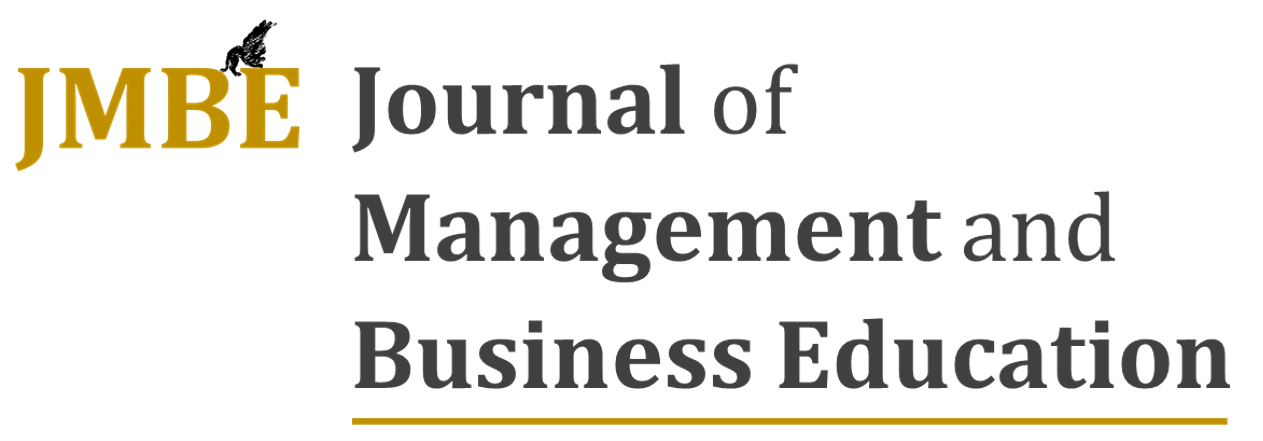Demographic and socio-economic determinants of multidimensional financial literacy among young Algerian university students
DOI:
https://doi.org/10.35564/jmbe.2023.0010Keywords:
financial literacy, university young students, financial knowledge, financial behavior, financial attitude, socio-economic factors, demographic factorsAbstract
Financial literacy is crucial for young university students to make sound financial decisions and improve their future well-being. This study examines demographic and socio-economic determinants of multidimensional financial literacy among young Algerian university students. The study employed a cross-sectional survey research design. It broadly adheres to the OECD definition of financial by segregating it into its main dimensions: financial knowledge, behavior, and attitude. Data was gathered from a sample of 368 university students and analyzed using multiple regression analysis. The study found a significant relationship between financial literacy, gender, the field of study, and bank account ownership. Female students are 3.64 times less financially literate than male students. Students majoring in scientific (hard) disciplines are 4.65 times more financially literate than non-scientific (soft) disciplines. Students with no bank account are 4.67 times less financially literate than those who own one. The study found a non-significant relationship between financial literacy and the variables: students’ level of education, the field of specialty, work experience, family income, father’s education level and mother’s education level. What is noticed is that the financial literacy level of economics and major in business students does not differ from those students of other majors.
Downloads
References
Adil, M., Singh, Y. and Ansari, M.S. (2022). How financial literacy moderate the association between behavior biases and investment decision? Asian Journal of Accounting Research, 7 (1), 17-30. https://doi.org/10.1108/AJAR-09-2020-0086
Agarwalla, Barua, S., J, S. J., & Varma, J. (2013). Effectiveness of financial literacy interventions in improving financial literacy among rural women in North India. Indian Institute of Management, Ahmedabad. October 2014, 1-32 https://doi.org/10.2139/ssrn.2338723
Amagir, Aisa, Wim Groot, Henriëtte Maassen van den Brink, Arie Wilschut. (2020). Financial literacy of high school students in the Netherlands: Knowledge, attitudes, self-efficacy, and behavior. International Review of Economics Education, 34. https://doi.org/10.1016/j.iree.2020.100185
Ana, A. S., & Wan Ahmad, W. M. (2020). Financial literacy among Malaysian Muslim undergraduates. Journal of Islamic Accounting and Business Research, 11(8), 1515–1529. https://doi.org/10.1108/JIABR-10-2017-0149
Ansong, A., & Gyensare, M. (2012). Determinants of university working-students’ financial literacy at the University of Cape Coast, Ghana. International Journal of Business and Management, 7(9), 126–133. https://doi.org/10.5539/ijbm.v7n9p126
Atkinson, A., & Messy, F.-A. (n.d.). Assessing financial literacy in 12 countries: an OCDE pilot experience.
Atkinson, A., & Messy, F. A. (2012). Measuring financial literacy: Results of the OECD/International Network on Financial Education (INFE) pilot study. https://doi.org/10.1787/5k9csfs90fr4-en
Babas, M., & Fali, N. (2020). The reality of the financial culture in the city of Setif- A survey study. Strategy and Development Review, 10(4), 377-396.
Brau, James C., Andrew L. Holmes, and Craig L. Israelsen. (2019). Financial literacy among college students. Journal of Financial Education, 45 (2), 179–205.
Celli, Viviana. (2022). Causal mediation analysis in economics: Objectives, assumptions, models. Journal of Economic Surveys, 36 (1), 214–234. https://doi.org/10.1111/joes.12452
Chaulagain, R. P. (2015). Contribution of Financial Literacy to Behavior. Journal of Economics and Behavioral Studies, 6(7), 61-71.https://doi.org/10.22610/jebs.v7i6(j).618
Cherabi, I. (2018). Financial Literacy and Retirement Preparedness among Algerians Who Have Reached the Age of Retirement. Les Cahiers du MECAS, 14(1), 31-41
Danes, S. M., & Hira, T. K. (1987). Money management knowledge of college students. Journal of Student Financial Aid, 17(1), 3–16. https://doi.org/10.55504/0884-9153.1435
Douissa, I. ben. (2020). Factors affecting College students’ multidimensional financial literacy in the Middle East. International Review of Economics Education, 35. https://doi.org/10.1016/j.iree.2019.100173
Driva, A., Lu, ¨. M., & Winter, J. (2016). Gender differences and stereotypes in financial literacy: Off to an early start. Economics Letters, 146, 143–146. https://doi.org/10.1016/j.econlet.2016.07.029
Fazli Sabri, M., Cook, C. C., & Gudmunson, C. G. (2012). Financial well‐being of Malaysian college students. Asian Education and Development Studies, 1(2), 153–170. https://doi.org/10.1108/20463161211240124
Gutter, M., & Copur, Z. (2011). Financial behaviours and financial well-being of college students: evidence from a national survey. Journal of Family and Economic Issues, 32, 699-714. https://doi.org/10.1007/s10834-011-9255-2
Happ, R., Hahn, J., Jang, K., & Rüter, I. (2022). Financial knowledge of university students in Korea and Germany. Research in Comparative and International Education, 17(2), 301-327. https://doi.org/10.1177/17454999221086357
Hasler, A., & Lusardi, A. (2017). The gender gap in financial literacy: A global perspective. Global Financial Literacy Excellence Centre, The George Washington University School of Business, 1-23, www.gflec.org
Herawati, Nyoman Trisna, I. Made Candiasa, I. Ketut Yadnyana, Naswan Suharsono. (2020). Factors that influence financial self-efficacy among accounting students in Bali. Journal of International Education in Business, 13 (1), 21–36. https://doi.org/10.1108/JIEB-02-2019-0010
Hung, A., Yoong, J., & Brown, E. (2012). Empowering women through financial awareness and education. OECD Working Papers on Finance, Insurance and Private Pensions. http://doi.org/10.1787/5k9d5v6kh56g-en
Johan, I., Rowlingson, K., & Appleyard, L. (2021). The Effect of Personal Finance Education on The Financial Knowledge, Attitudes and Behaviour of University Students in Indonesia. Journal of Family and Economic Issues, 42(2), 351–367. https://doi.org/10.1007/s10834-020-09721-9
Kadoya, Y., & Rahim Khan, M. S. (2020). Financial literacy in Japan: New evidence using financial knowledge, behavior, and attitude. Sustainability, Switzerland, 12 (9). https://doi.org/10.3390/su12093683
Kartawinata Budi Rustandi, Mahendra Fakhri, Mahir Pradana, Nouval Faiz Hanifan, and Aldi Akbar. (2021). The role of financial self-efficacy: Mediating effects of financial literacy & financial inclusion of students in West Java, Indonesia. Journal of Management Information and Decision Sciences, 24 (7), 1–9.
Kempson, E., Perotti, V., & Scott, K. (2013). Measuring Financial Capability: A New Instrument and Results from Low-and Middle- Income countries. London: Financial Services Authority.
Kiliyanni, A., & Sivaraman, S. (2018). A predictive model for financial literacy among the educated youth in Kerala, India. Journal of Social Service Research, 44(4), 537–547. https://doi.org/10.1080/01488376.2018.1477699
Lantara, I., & Kartini, N. (2015). Financial literacy among university students: empirical evidence fromIndonesia. Journal of Indonesian Economy and Business, 30(3), 247-256. https://doi.org/10.22146/jieb.10314
Liaqat, F., Mahmood, K., & Ali, F. H. (2021). Demographic and socio-economic differences in financial information literacy among university students. Information Development, 37(3), 376–388.https://doi.org/10.1177/0266666920939601
Loke, Y. (2017). The influence of socio-demographic and financial knowledge factors on financial management. International Journal of Business and Society, 18(1), 33–50. http://doi.org/10.33736/ijbs.488.2017
Mitchell, O. S., & Lusardi, A. (2011). Financial literacy around the world: An overview. Journal of Pension Economics and Finance, 10(4), 497-508. http://doi.org/10.1017/S1474747211000448.
Morgan, P. J., Huang, B., & Trinh, L. Q. (2019). The need to promote digital financial literacy for the digital age. The future of work and education for the digital age, Japan, March 15.
Lusardi, A., & Mitchell, O. (2014). The economic importance of financial literacy: theory and evidence. Journal of Economic Literature, 52(1), 5-44. http://doi.org/10.1257/jel.52.1.5
Lusardi, A., Mitchell, O., & Curto, V. (2010). Financial literacy among the young. Journal of Consumer Affaires, 44(2), 358-380.https://doi.org/10.1111/j.1745-6606.2010.01173.x
Mandell, L. (2008a). Financial literacy of high school students. In: Xiao, J.J. (Ed.). Handbook of Consumer Finance Research. Springer, New York, 163-183 https://doi.org/10.1007/978-0-387-75734-6_10
Mandell, L. (2008b). The Financial Literacy of Young American Adults Washington. Results of the 2008 National Jump$tart Coalition Survey of High School Seniors and College Students. Washington, DC: The Jump$tart Coalition for Personal Financial Literacy. https://doi.org/10.22251/jlcci.2018.18.15.999
Mändmaa, Sirli. (2020). Personal Financial Literacy among University Students studying Engineering. International Journal for Innovation Education and Research, 8 (8), 669-690. https://doi.org/10.31686/ijier.vol8.iss8.2575
Martin, C. A., & Bush, A. J. (2000). Do role models influence teenagers’ purchase intentions and behavior? Journal of consumer marketing, 17, 271-290. https://doi.org/10.1108/07363760010341081
National statistic office, (2020). Demographie Algerienne. 949: National statistic office, ONS.
Nidar, S., & Bestari, S. (2012). Personal financial literacy among university students case study at Padjadjaran University students, Bandung, Indonesia. World Journal of Social Sciences, 2(4), 162–171.
OECD. (2017). OECD. PISA 2015 Results: Students’ Financial Literacy. Paris, France,: OECD Publishing.https://doi.org/10.1787/9789264270282-en
OECD. (2018). OECD/INFE Toolkit for Measuring Financial Literacy and Financial Inclusion.
https://doi.org/10.1787/9789264254855-10-en
OECD. (s.d.). The Importance of Financial Education. Policy Brief. sur http://www.oecd.org/finance/
Othmani, z. e., & larbi, t. (2022). Diagnosing The Extent of Financial Culture Among University Students, A Study of a Statistical Sample of Ahmed Deraya University Students Adrar. Journal of Economic Integration, 10(2), 434-449
Pallant, J. (2013). SPSS survival manual: a step by step guide to data analysis using IBM SPSS (5th ed.). Berkshire: Open University Press. https://doi.org/10.4324/9781003117452
Park, C. M., Kraus, A. D., Dai, Y., Fantry, C., Block, T., Kelder, B., Howard, K. A. S., & Solberg, V. S. H. (2021). Empowering women in finance through developing girls’ financial literacy skills in the United States. Behavioral Sciences, 11(12). https://doi.org/10.3390/bs11120176
Santini, F. D. O., Ladeira, W. J., Mette, F. M. B., & Ponchio, M. C. (2019). The antecedents and consequences of financial literacy: a meta-analysis. International Journal of Bank Marketing, 37(6), 1462–1479. https://doi.org/10.1108/IJBM-10-2018-0281
Shaari, N. A., Hasan, N. A., Mohamed, R. K., & Sabri, M. A. (2013). Financial literacy: A study among the University students. Interdisciplinary Journal of Contemporary Research in Business, 5(2), 279–299
Shim, S., Barber, B., Card, N. A., Xiao, J. J., & Serido. (2010). Financial socialization of first-year college students: The roles of parents, work, and education. Journal of Youth and Adolescence, 39(12), 1457–1470. https://doi.org/10.1007/s10964-009-9432-x
Son, J. and Park, J. (2019). Effects of financial education on sound personal finance in Korea: conceptualization of mediation effects of financial literacy across income classes, International Journal of Consumer Studies, 43 (1), 77-86. https://doi.org/10.1111/ijcs.12486
Świecka, B. (2019). A theoretical framework for financial literacy and financial education. In Financial Literacy and Financial Education (pp. 1–12). De Gruyter. https://doi.org/10.1515/9783110636956-001
Tabachnick, B., & Fidell, L. (2013). Using multivariate statistics (6th edn). Pearson Education.: Boston.
Xiao, J. J., & O’Neill, B. (2016). Consumer financial education and financial capability. International Journal of Consumer Studies, 40(6), 712–721. https://doi.org/10.1111/ijcs.12285
Zaibet, m. s., & cherabi, i. e. (2020). The level of financial literacy among economics students in university Constantine-2-. The Journal of Human Sciences, Larbi Ben Mhidi de Oum El Bouaghi university, 1261-128
Downloads
Published
How to Cite
Issue
Section
License
Copyright (c) 2023 Journal of Management and Business Education

This work is licensed under a Creative Commons Attribution-NonCommercial-ShareAlike 4.0 International License.
License terms at: https://creativecommons.org/licenses/by-nc/4.0/legalcode




